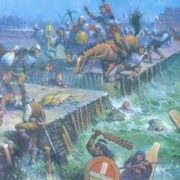“Noche Triste” 1520
On June 30, 1520, the night air of Tenochtitlán was filled with the screams of battle as the Aztecs attempted to push Hernándo Cortés and his band of Spanish invaders from their capitol city. Nearly 900 Spaniards and over 1,200 of their Tlaxcalan allies were killed. The dark night also marked the death of the ninth Aztec emperor, Moctezuma, who had once ruled an empire that stretched as far north as present day Honduras and Nicaragua. The Aztecs were eventually defeated by guns, germs, and steel. The chronicler of events wrote, “Yet the Aztecs never surrendered; to occupy their city, Cortés had to ravage it. No temple, palace, or idol survived.” The present day Mexico City is built on the ruin of this “Noche Triste”, or “Night of Tears”.
El 30 de junio de 1520, el aire de la noche de Tenochtitlán se llenó con los gritos de batalla como los aztecas intentaron empujar Hernando Cortés y su banda de invasores españoles desde su ciudad capital. Cerca de 900 españoles y más de 1.200 de sus aliados tlaxcaltecas murieron. La noche oscura también marcó la muerte del noveno emperador azteca, Moctezuma, que había gobernado un imperio que se extendía hacia el norte hasta nuestros días Honduras y Nicaragua. Los aztecas fueron derrotados por las armas, gérmenes y acero. El cronista de los acontecimientos escribió: “Sin embargo, los aztecas nunca se rindió, a ocupar su ciudad, Cortés tuvo que saquear Ningún templo, palacio, o ídolo sobrevivido.”. La actual ciudad de México está construida sobre las ruinas de la “Noche Triste”, o “Noche de las Lágrimas”.

